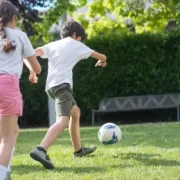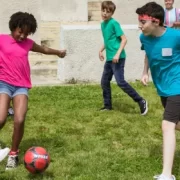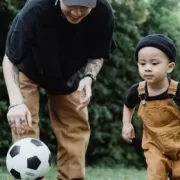Steps for Kids to Learn Soccer
Soccer is a fun game and a sport that is not only good for your kids, physically but mentally as well. However, learning soccer requires effort from both parents, coaches, and students. At first, learning to play soccer as a kid might be strenuous.
But if you truly want your kids to excel in the game and want them to play in a youth soccer club, you have to follow some steps to help your kids learn soccer and help them with soccer skills training.
However, these steps are not known to many people that want to help their kids learn soccer. Today, we will discuss all the steps for kids soccer.
A complete guide on Steps for kids to learn soccer
Some of the steps that can help your kids learn soccer are specified below.
Infuse a sense of excitement in them
One of the primary steps that you, as a parent, can take to help your kids to learn soccer is to create a sense of excitement for the sport.
Soccer is a game of passion, and it is why you see soccer players expressing different emotions when they lose or win a game. You can build up your kids’ interest in soccer by putting your kid behind a soccer ball, and having them play with it.
Kicking the ball would help your kids be more explosive, which is exactly what you want in a soccer game. Moreover, following this step would also ensure that whether your kid is interested in games like soccer or not.
For example, if you think that your kid is not kicking the ball or not having fun while playing with it, it may be a sign that he/she is not motivated enough about the game.
For you to get them motivated, you can show them soccer videos, and create a small soccer playfield in your backyard and have them play with a soccer ball daily. All this might add a remarkable difference as well.
Educate them about soccer rules
The next step that you can take to get your kids to learn soccer is to educate them about the kids soccer rules. If your kids are a bit young for example, 3-4 years old, then tell them some of the basic soccer rules like:
- What is a goal,
- Penalty,
- Tackle, and so on. If your kids are a bit old, you can teach them rules, including offside rules and back pass too.
Teaching your kids about the basic rules of the games is essential as without it your kids would not learn about the discipline in which they should play soccer. Moreover, teaching them about the rules would also help your kids learn that soccer is a gentleman’s game.
Teach them the attitude they need to display when playing the game
Another thing you as a parent, or a coach do to help your kids learn soccer is to teach them the attitude and mindset they should have on the field. A little bit of aggressiveness is not a problem it is necessary to win the game.
However, too much of it can be a problem and can ruin the discipline of the game. Tell your kids that winning and losing are part of the game, and focus on how they can have fun.
Kids below 10 and 11 years should not be told how to score more goals as this can take out the fun from their minds, which is not what you want.
Instead at an early age, kids should only have fun while playing the game, as this motivates and excites them about the sport.
Teach them how they can build coordination in the game
Communicating is one of the most crucial parts of any sport as it is the reason for proper coordination. It is particularly true for soccer, and it is why you need to tell your kids about how they can communicate with their team members on the field.
Some soccer terms are used by soccer players that you can teach your kids to help them communicate. Some of those are:
- Man – It is said when you see an opponent coming towards your team member to get possession of the ball. Shouting “man” lets your team member know that there’s not enough time and they need to act fast with the ball.
- Time – Time is a term that is said by soccer players when they see that their team members are not surrounded by opponents. Or there isn’t any opponent player rushing towards them. Shouting time ensures that your team member cools down his nerves and then decides about what he should do with the ball.
- Say your team member’s name out loud – It is when there is a chance of you colliding with your team member while receiving or running for the ball.
- Mark up – It is said when you want your team members to cover individual opponent team members.
Teaching your kids these soccer terms help your kids to pass and shoot with coordination, which helps them win a soccer game.
Teach them the basic skills they need in the game
As specified earlier, we told you how passing and shooting with coordination can help your kids win a soccer game. However, this only implies when they know how to shoot and pass. It is why you must get your kids to learn the basic skills that include passing, dribbling, and shooting.
Passing
Passing is one of the crucial skills your kids need to learn in a soccer game. Passing helps a team keep possession of a soccer ball for a longer time.
Without accurate passing, there’s a high probability of your kids just giving possession of the soccer ball to the opposing team players.
To help your kids learn how they can pass accurately, you can teach them things like:
- To pass the ball with the inside part of their foot. Passing with the inside part of the foot improves the accuracy of the pass.
- Always keep your eyes on the ball. Losing eye contact when passing the soccer ball can result in an inaccurate pass. Moreover, you must tell your kids to always have their heads steady.
You can also get your kids to practice some basic soccer drills to improve the accuracy and power of their passes. Some of those drills and soccer skills training include:
- Placing the soccer ball on top of a cone and standing 5 meters apart from the cone. Then get your kid to kick the soccer ball off the cone. You can always increase the distance of the cone to increase the difficulty level.
- Another one of the basic soccer drills that you can get your kids to practice for powerful passes is the wall pass drill. Get your kid to stand up a few meters away from a wall with the ball beneath his/her feet, and then make them kick the ball on the wall.
Kicking the soccer ball against the wall would ricochet the ball. And it would help your kids learn how they can receive powerful passes without losing control of the ball.
Shooting
Shooting is another primary skill that every soccer player should have. Accurate and powerful shots help you put the ball into the goal, which is what you want if you want to win the game.
Some steps that you can tell your kids to help them with shooting a soccer ball are:
- Always keep your eye on the ball. Keeping an eye on the soccer ball also helps you fully connect your foot with it. All of this increases the accuracy and power behind the shot.
- Keep your head up. Make sure to tell your kids to keep their heads up and focus on the area they are looking to shoot the ball.
- Take even strides. Get your kids to practice taking even strides before kicking the ball. The ideal strides that a soccer player should take must be 3. Both less and way more strides can throw off your balance, which results in weak and inaccurate shots.
- Kick the ball with the laces. Shooting a soccer ball with the laces area on your shoes is the key to powerful shots.
There are numerous soccer drills for kids that they can practice to improve their shooting skills. Some of the basic soccer drills for shooting are:
- Shooting into an empty goal. Shooting the ball into an empty goal helps kids to be more accurate when shooting. Plus, this drill would also help your kid develop his, or her kicking technique using which they can shoot more powerful shots.
While practicing this drill, make sure to tell your kids to aim for the top corners as it is hard for goalkeepers to stop the ball that lands there.
- Shooting into a goal with a goalkeeper. Shooting the soccer ball into the goal with a goalkeeper in it would help your kids to become familiar with the situation they would face in a real soccer game. This drill would also help your kids come with techniques, in which they can put the ball into the goal by deceiving the goalkeeper.
Dribbling
Dribbling is also an essential skill that your kids should learn if you want them to ace the game. Dribbling ensures that defenders and other members of the opponent team do not gain possession of the soccer ball.
Dribbling also creates opportunities to score more goals. Some of the things that kids should learn when dribbling is:
- Make small touches as dribbling the ball with powerful touches would have you lose your balance and lose the ball’s possession.
- Foot distance should not be not too much. Your kids’ feet should be too wide open, and the ball should always be near the feet.
- Form a shield. While dribbling, there is a chance that your opponents would intercept the ball and gain possession of the ball. It is why you must form a shield when you see players coming towards you. Make sure to spread your arms, and give a little push using your shoulder to prevent them from possessing the ball.
Some of the basic soccer drills that can help the kids to learn fantastic dribbling are:
- Placing two cones. Placing two cones apart from each other at a distance of 2 meters and dribbling the ball in between them help kids learn about how lightly they should touch the ball that would retain their balance and help them keep possession of the ball.
Some other skills that your kids learn to help them play soccer
Dribbling, passing, and shooting are the key elements of the game. However, there are some other skills that you can teach your kids by yourself or by getting them enrolled in a youth soccer academy.
Some of those skills are:
- Chipping the soccer ball. Chipping the soccer ball is a cheeky skill that helps you beat defenders. This skill comes in handy when you are sprinting too fast with the ball in your feet and a defender is progressing towards you. To chip the ball, you need to use your toe and kick just below the center of the ball.
- Curving the soccer ball. Swinging the soccer ball is not easy, but if mastered, can make a huge difference in a match. To bend the ball, you need to kick the ball at its bottom right to curve it anti-clockwise and at the bottom left to curve it clockwise.
Other things you can do to help your kids learn soccer
Other things that can help your kids learn soccer are:
- Watching soccer with them. Watching pros play the game can ignite the interest of little ones in the game, and they can learn more about soccer as well.
- Get them enrolled in a school soccer team. Playing in a team would help your kids to polish the skills they learned while soccer skills training.
Conclusion
By now, you must know the steps you need to take to get your kids to learn soccer. If you are a busy person but still want your kids to be playing the sport, you can contact a youth soccer club.







